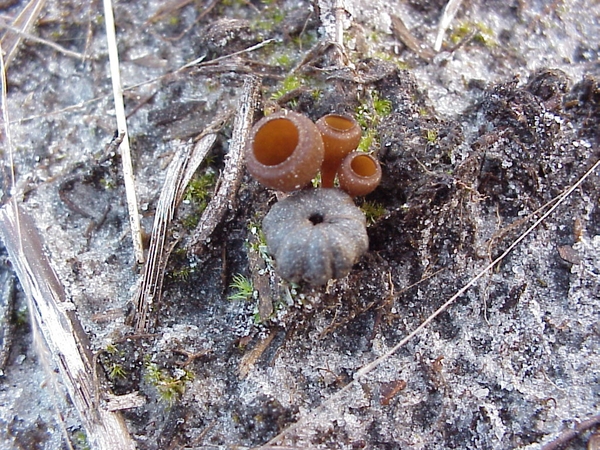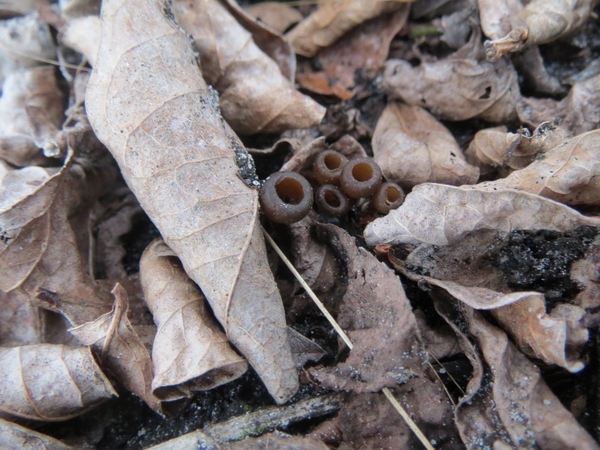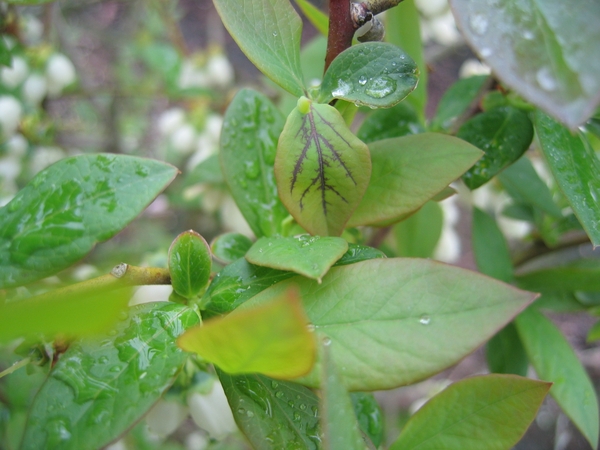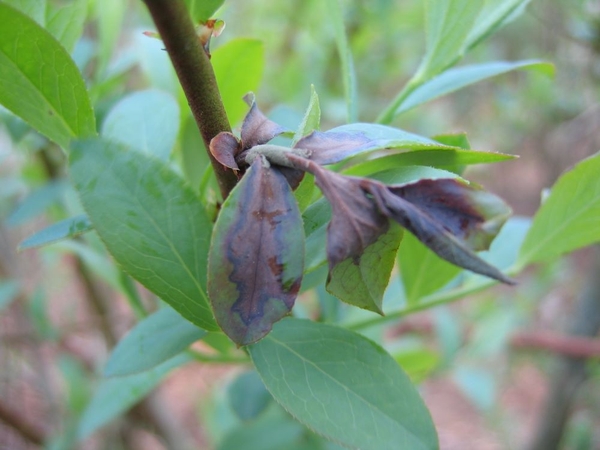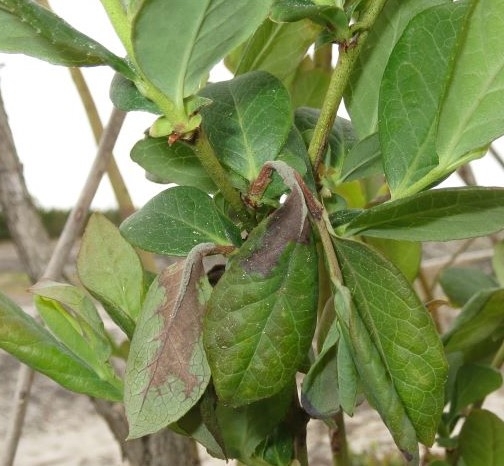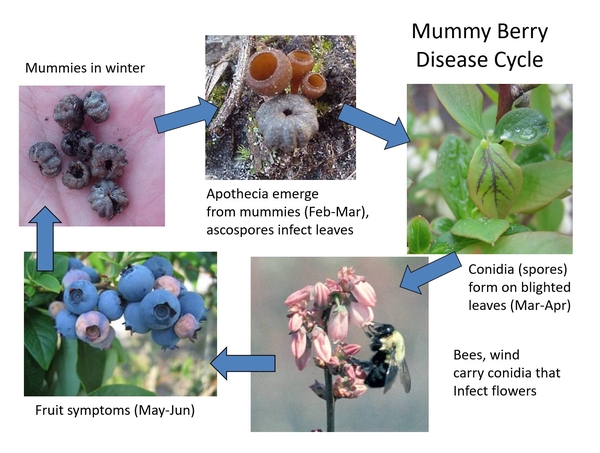Introduction
Mummy berry is a fungal disease common among blueberry species in North America. Yield losses can result from shoot blight, flower cluster blight, and fruit mummification. Mummy berry is caused by the fungus Monilinia vaccinii-corymbosi. The pathogen has distinct life phases. First, the fungus is windborne and infects developing blueberry leaves – causing shoot blight. Second, the fungus is spread by wind, rain, or pollinators to flowers, causing fruit infections. Infected fruit shrivel into so-called “mummy berries” that drop to the ground. These “mummy berries” overwinter on the ground and are the source of infection the following year. Cultural practices can reduce blueberry infection. Raking, cultivating, and/or mulching underneath blueberry bushes can bury mummies and reduce further spread. Fungicides can effectively manage mummy berry disease. Several different fungicide classes are labeled for use against mummy berry. Rotating between different active ingredients prevents the evolution of fungicide resistance.
General Information
Mummy berry is a disease of blueberry that affects both leaf shoots and berries. The causal fungus overwinters on the ground, and in spring produces a cup-shaped mushroom that releases spores. These spores infect and kill emerging leaf shoots, causing the shoot blight (primary) phase of the disease. Blighted shoots then produce a second type of spore that is carried by insects to the flowers, where fruit (secondary) infection takes place. The end result is “mummies” – berries that do not turn blue, but instead turn pink or salmon-colored and fall to the ground. Mummy berry is an important pathogen in many blueberry-growing regions of the US. Infected berries are unsightly and unmarketable, and severely infected fields can suffer heavy yield losses. In addition, severe blighting of emerging leaf shoots and flower clusters can occur on susceptible cultivars. The name of the disease comes from the shriveled, pale appearance of infected fruit.
Symptoms and Signs
The first sign of mummy berry occurs on the ground under the bush in February and March, when apothecia or “mummy cups” emerge from last year’s infected fruit. In April, shoots infected by spores from the mummy cups will begin to wilt. This blight symptom (primary infection) on individual infected shoots can be sparse and hard to find, or there may be hundreds of strikes per bush. A further diagnostic sign of the pathogen is the production of a mass of ash-gray conidia (spores) along the midrib of the leaves on blighted leaf shoots. The next visible symptom occurs at harvest, when infected berries (mummies) turn a salmon-pink color, with soft deteriorating skin and a hard fungal structure (pseudosclerotium) inside. Infected, non-symptomatic green berries contain white fungal tissue that can be seen by cutting the unripe berry open. This fungal tissue develops a black, hard rind as the berry matures. Infected fruit is soft on the surface with a hard fungal structure inside. Most mummies fall to the ground just before harvest or during the first picking, drying to whitish-gray hard structures
Pathogen and Disease Cycle
Mummy berry is caused by the plant pathogenic fungus Monilina vaccinii-corymbosi. Infected berries from the previous year are the initial source of infection. In early spring, small cup-shaped spore-bearing structures called apothecia are produced from overwintering mummies on the ground. These mummies break dormancy around the same time that the blueberry buds begin to swell in spring. Mummies develop mature apothecia about one month later, when blueberry leaf shoots are emerging. Spores (ascospores) produced by the apothecia are liberated during cool, wet weather and are carried by air currents to the young emerging leaf and flower shoots. These spores infect and blight the young shoots. The secondary spores (conidia) are produced in great abundance on the blighted leaves. These conidia are carried mainly by pollinating insects to open flowers, where they infect developing fruit in the flower stage. During harvest, infected berries become light cream-color rather than normal blue and drop to the ground. These infected berries, if left on the ground, persist as overwintering mummies and provide a source of disease the following year.
Best Management Practices
Avoidance can be used by anyone who is producing blueberries in an isolated location. Unless the disease is present in wild or cultivated bushes nearby, growers and homeowners can avoid mummy berry by planting only disease-free, dormant plants. This avoids introducing mummies or infected leaf shoots into the new planting.
Sanitation can be used to reduce the incidence and severity of disease by removing or burying the overwintering mummies. Hand raking or the use of a leaf blower around bushes can be used to move mummies to the aisles between rows where they can be disked under or collected with a bagging mower.
Mulching – Mulch applied 3-4 inches deep underneath bushes will prevent mummies from emerging in Spring. Mummies buried at depths of an inch or more are not able to emerge through the mulch layer and are thus prevented from producing spores.
Fungicides – Fungicidal control has proven very successful. Fungicides are used at leaf emergence to prevent primary (leaf shoot) infection, and again during bloom to prevent secondary (flower) infection. Since fungicide labels and recommendations may change, consult annually revised extension publications for specific recommendations, such as the North Carolina Agricultural Chemicals Manual, or the crop-specific management guides at https://smallfruits.org/.
Resistance is the ability of the plant to withstand (resist) infection by a pathogen. Rabbiteye blueberry cultivars that have shown some resistance to mummy berry include Premier, Columbus and Powderblue. Southern highbush cultivars that have exhibited resistance include Legacy, O’Neal and Star. Resistant northern highbush cultivars include Duke and Elliot.
Publication date: Jan. 3, 2014
Reviewed/Revised: Feb. 11, 2022
N.C. Cooperative Extension prohibits discrimination and harassment regardless of age, color, disability, family and marital status, gender identity, national origin, political beliefs, race, religion, sex (including pregnancy), sexual orientation and veteran status.

